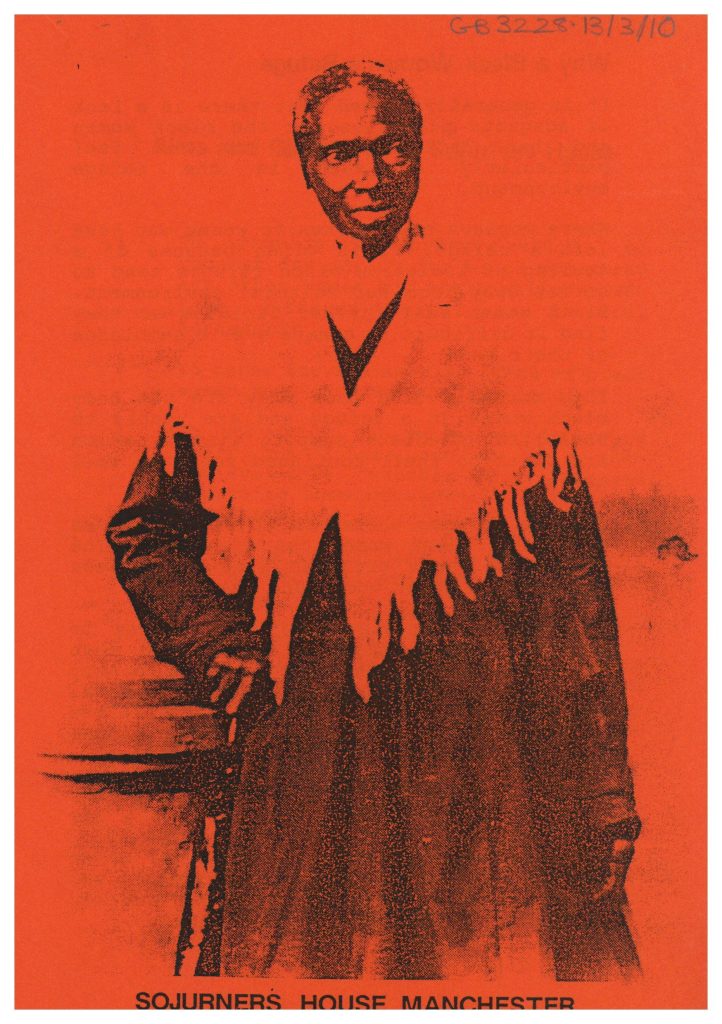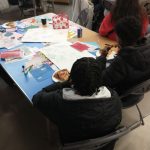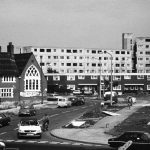To mark International Women’s Day 2025 we’d like to introduce Marilyn Cuffy, and the archive she donated to us. We feature Marilyn not only because she’s an inspirational woman in her own right, but also because she has worked over years to further the rights of Black and Global Majority women and to support them to find their voices.
Maya Sharma, our Collections Engagement Officer, writes about the collection and Marilyn’s life, sharing elements from a conversation she had with Marilyn.
Introduction
As Engagement Officer I work with a range of archive collections held at the Ahmed Iqbal Ullah RACE Centre. All our collections are fascinating there are a few that I find myself particularly drawn to. The Marilyn Cuffy collection (GB3228.13) is one of these. This collection offers valuable insights into the challenges that Black and Global Majority women were facing through the 1980s and 1990s. Many of the archive items document the history of Black women’s resistance and perseverance in the face of racism, sexism and other forms of discrimination. We can learn about the skilful and varied ways in which they challenged discrimination and advocated for their needs.
I particularly enjoy sharing these histories with the young activists I work with, inviting them place themselves in the long timeline of Black women’s activism. Through looking Marilyn’s work and the activism of many other Black and Global Majority women, there are opportunities to explore different forms of activism and of realising change.
I was delighted, therefore, to meet Marilyn at one of our community events, and she kindly agreed to having a chat with me at a later date. I wanted to find out more about her life and activism, to better understand the context for the collection she donated.

Marilyn is discovering England’s “green and pleasant land” at Lake Windermere, 2023: She described this visit as giving what her body needed at that time “I stand on solid ground, earthy nature replenishing my vibrancy for living”.
Early life / education
Marilyn was born in Dominica (not to be confused with the Dominican Republic) in the Caribbean in 1952. Or she puts it: “the year that Kwame Nkrumah became the first Black Prime Minister of the country that would become Ghana, and Elizabeth acceded to the throne after her father, George VI died.”
Her parents migrated to the UK, leaving Marilyn and her sister with their grandparents. Her parents then called her to join them to the UK in 1962. This was a shock to the system:
“It’s so dark and cold and it was…cold and foggy and grey and I’m thinking oh my god is that England? At school, and in church we always used to sing the song… “England green and pleasant land”… England is green, but it’s not, it wasn’t green in that area, you know!”
There were other shocks: her parents had had four more children after they arrived in the UK, so Marilyn and her sister had to get to know these siblings. Marilyn’s family lived in Paddington in London, and she went to a local school there. Here she was struck by the differences in education in the UK and back home:
“And I was surprised that.. at that age, no one knew the times tables…Whereas we know our timetables by rote, you had to know what two times two, whatever. And the grammar, they didn’t know about the grammar but we had learned all that. We had all that basic information, you know, basic things that they didn’t know all this. I’m thinking they say they’re better, they’re better than me!”
Although Marilyn was clearly bright no-one encouraged her to think about higher education. She was put down to take CSEs rather than O levels, an act which she later realised would limit her educational prospects. Had Marilyn stayed in Dominica she would have had to option of taking the equivalent of the 11 plus, which would – if she’d passed – given her access to high quality education which generally led onto academic study.
Instead, in London she went to a local college where she took secretarial studies. At the same time, she took O levels in evening classes, having realised that holding only CSEs was limiting her educational options. After this she started working in administration roles in various companies. She later completed a degree as an adult student.
I asked Marilyn what prompted her to pursue higher education: “..the thing that triggered some of my going to university, I remember there was a guy who was from uni, he was doing a BA in Trade Union studies. And he wanted to photocopy something, and I was the secretary there… And I had to show him three times how to do the photocopy. I thought: but you are at university! ….I said, so what is at university that people are saying that you can’t go to? And this man in there?…So that got me thinking about, you know, further education and stuff like that.”
Another impetus was how, when volunteering on an adult education course in London, her students had told her that she should consider becoming a teacher (saying she was much better than some of the other, qualified, teachers!).
Having moved from London to Bradford to take a journalism degree course (which unfortunately, didn’t run due to low numbers); instead, she took a Diploma in Higher Education. After that, she completed a course which lead to a BA in Organisation Studies. She then moved to Manchester to take a post graduate Youth and Community Work qualification.
Community activism and organising
Even a quick glance at the Marilyn Cuffy collection shows how deeply Marilyn was involved in community organising, anti-racist activism, and – in particular – advocating and campaigning for Black and Global Majority women’s rights.
I was interested to know why Marilyn had always engaged in activism, whether paid or unpaid. She referred back to her upbringing in Dominica, in an agricultural community. Mutual support had been an part of everyday life there: if people had an excess of any particular crop, for example, they would give it to others in the community. She also described her grand-mother playing a vital role in her church, and how when her grand-father slaughtered an animal he would share out the meat with others in the community. Knowing this, I could see some early formative influences that must have contributed to Marilyn’s life-long drive support others and build community.
Size 8 magazine
Although Marilyn was involved in national and regional work, a lot of her local work was focused in and around Cheetham Hill, in north Manchester. Although there was a sizeable Caribbean (and African) community, she found that a lot of people had to travel to Moss Side to find services and activities that met their specific needs. As a result, Marilyn worked hard to develop local responses to these needs.
One of these projects was setting up the Talibah (meaning: seeker of knowledge) young women’s group. She had been a Neighbourhood worker at the time, based at Abraham Moss Community Centre. Marilyn had formed the group to give a focus for young women, for them to offer mutual support and to find a voice for themselves. Part of this work was working with to young women, supporting them to write and publish the Size 8 magazine in 1983.


Image: GB3228.13/11/30 Size 8 front cover and foreword
Marilyn talks about how the Size 8 came about: “I was employed as a neighbourhood worker, so I had different responsibilities…my women’s group was part of MY development in terms of the needs of women in the locality….And the magazine was a way of getting them to bring that together.”
Despite only publishing one issue of Size 8, it clearly had a strong impact on the young women, giving them a voice and boosting their confidence. Forming and being part of the group clearly had a lasting legacy, as Marilyn told me that the group are still connected and have had several reunions, now operating as Cheetham Community Collective.

Photo supplied with permission to share. Caption: Marilyn, Lorraine, Jerish, Juliette, Joan, Sandra in October 2016 (credit: Anthony Oladele Hamilton)
I often show Size 8 to young people I work with. Without exception, they find the magazine fascinating, and are really interested to see how some of the pressures and challenges the authors experienced are, in some ways, similar to their experiences today. Some are also excited by the materiality of the magazine in a very digital age, and it’s sparked conversations about creating their own printed magazines, today.
Sojourner’s House
I’d also like to highlight the instrumental role that Marilyn played in a project with significant reach: the establishment of a specialist domestic violence service for Black women.
Although Women’s Aid services existed, they were seldom able to cater for the specific needs of Black women (in some cases, it’s doubtful they even understood or recognised these needs). Marilyn was a founder member of the Black Women’s Commune Group, which worked steadily for years to highlight how Black women’s needs weren’t being met, and to advocate for a specialist refuge for these women.
The Black Women’s Commune Group became Sojourner’s House. We can see how the group worked hard to make the case for a specialist refuge, as documented in records such as the leaflet

Image: GB3228.13/3/10 Sojourners House leaflet (pages 1,2,3)
“Why a Black women’s refuge?” This is another item I often use in engagement with young people, and it’s interesting to see their reactions. In many cases they are surprised that Marilyn and fellow activists had to work so hard to make the case for the refuge; for many young people the need for specialist services is obvious and unquestionable.
Fortunately, they were eventually successful, and Sojourner’s House was established in as a refuge. It operated for some years but was subsequently subsumed by Manchester Women’s Aid in the early 1990s due to funding challenges. Despite this, Sojourner’s House still remains a significant piece of local activism. It also illustrates how second wave feminism left Black and Global Majority women to advocate for their own needs.
The collection
We’ve highlighted two important aspects of Marilyn’s work, but there is so much more to explore in the collection she donated to the AIU 2015. The collection includes a wide range of personal and organisational records relating local and national activism with a strong focus on anti-racism and Black and Global Majority women’s needs. It reflects Marilyn’s interest in youth work and education, as well as in community development work and employment rights. We can also find papers relating to national activism and anti-deportation campaigns that Marilyn was involved in or following.
We encourage readers to explore the collection via our online search facility (a good start is to type Marilyn Cuffy into the search bar). Alternatively, email us at [email protected] for the collection catalogue (a document which lists all items within the collection)
Reflecting on her life’s work
As we talked, Marilyn reflected on the impact of her life’s work. She recounted how she was flagged down by a man who described how she’d helped his wife:
“His wife apparently, she was thinking of doing studies and she came to speak to me and I said, “I won’t remember”. He said “well I just thought I would say thank you because whatever you said to her…she actually went into the social course, social work course and she’s a social worker and I just wanted to thank you for that.”
As we brought our conversation to a close I asked Marilyn if she had any advice for young Black women today.
“Be true to yourself. You’ve got the skills, and the knowledge and…awareness… to effect change! ……. And they have to choose their battles well, that’s what I said to my daughter… They have to choose their battles well because there’s so much, that people could be angry about and fight about.”
At a time when the world seems an increasingly difficult place for many people, including women and girls, this advice to pick our battles and conserve our energies feels very sound.
Marilyn described her work as “you drop a little ripple”; that ripple is captured in the collection she donated to the Ahmed Iqbal Ullah RACE Centre and Education Trust. I encourage anyone who seeks inspiration to sustain their activism, or to understand how Black and Global Majority women fought for the space and services they needed, to explore the collection.





